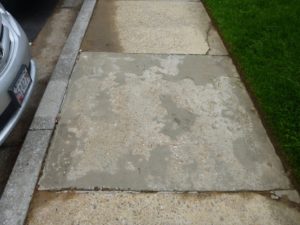Scaling Concrete Surfaces

 Is your concrete peeling or flaking in localized areas? Are you noticing rough, aggregate surfaces in your concrete that haven’t been there before, particularly after the latest round of winter weather? If so, your concrete may be experiencing a condition called scaling.
Is your concrete peeling or flaking in localized areas? Are you noticing rough, aggregate surfaces in your concrete that haven’t been there before, particularly after the latest round of winter weather? If so, your concrete may be experiencing a condition called scaling.
Scaling occurs when a thin layer of the concrete surface flakes, or scales, from the concrete element. Removal of this thin layer often exposes the underlying, open-pore structure of the concrete, which poses a durability concern. The most common causes of scaling are listed below.
- Non- or Low-Air-Entrained Concrete – Air-entrained concrete contains small voids which accommodate volume changes when water (i.e. precipitation) in the concrete freezes and expands. If the concrete is not properly air entrained, the concrete surface may be overcome by expansive forces during freeze-thaw cycles, resulting in loss of material.
- Unsuitable Concrete Mix – Concrete mixes with low strength (less than 4,000 psi in exterior, exposed conditions) or those with high water-to-cement ratios are more susceptible to water intrusion and deterioration.
- Excessive/Improper Deicing Agents – These chemicals can attack surface layers of concrete. These chemicals can also create brines (which have lower freezing points than fresh water), and can increase the number of freeze-thaw cycles.
- Poor Finishing – Overworked concrete surfaces or those that receive additional water and or finished with bleed water can result in reduced entrained air content or weak, thin, cementitious paste deposits at surfaces.
Repairing scaled concrete surfaces can prove difficult. If a proper bond is not achieved between the cementitious topping/overlay and the underlying concrete, additional scaling or delamination may occur. If scaling is prevalent in your community, contact a professional engineer to determine the extent of the damage and to develop the proper repair strategy.
